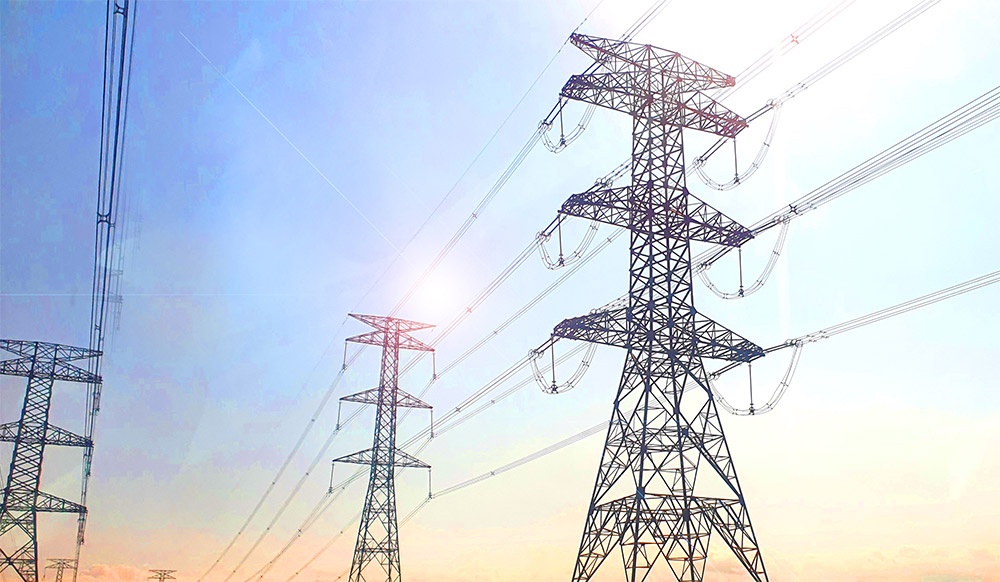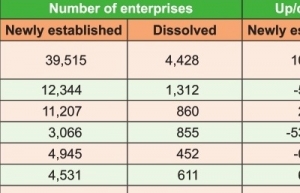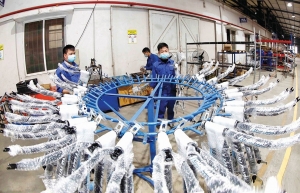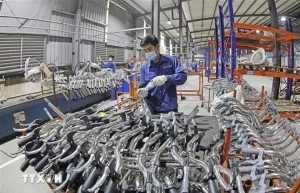Key balances maintained for industrial production
Prime Minister Pham Minh Chinh last week emphasised the need to accelerate growth in the fourth quarter to achieve an economic expansion of 7.4-7.6 per cent, ensuring the annual growth rate surpasses 7 per cent with inflation kept below 4.5 per cent.
“The main achievement in the first 10 months has been a stable macroeconomy with controlled inflation, sustained economic growth, and all key balances maintained,” PM Chinh said. “The socioeconomic outlook has improved consistently each month, quarter, and year. Should GDP exceed 7 per cent this year, all 15 primary targets for 2024 will be achieved.”
According to PM Chinh, the domestic production landscape has been steadily improving, and enterprise confidence is building. The Purchasing Managers’ Index reached 51.2 points in October, signalling continued expansion in production.
Data from the General Statistics Office (GSO) reflects an uptick in industrial production, fuelled by rising demand both domestically and internationally.
 |
| Key balances maintained for industrial production |
Vietnam’s industrial production index (IIP) for October climbed by an estimated 4 per cent on-month, continuing a positive trend with an overall increase of 7 per cent on-year. The IIP for the first 10 months saw an estimated rise of 8.3 per cent compared to the same period last year, when growth climbed just 0.5 per cent.
The processing and manufacturing sector led the growth, with an IIP increase of 9.6 per cent on-year. Other key sectors also showed strong performances, with waste management up 9.5 per cent and electricity production and distribution up 10.3 per cent on-year.
Vietnam Electricity (EVN) has reported robust results in the first 10 months of 2024. The group’s total electricity output – both domestically produced and imported – reached an estimated 258.7 billion kWh, marking a 10.6 per cent on-year rise.
In October alone, output on the national grid totalled 20.44 billion kWh, a 7.5 per cent increase. Across the 10-month period, EVN recorded an 11.2 per cent increase, largely driven by demand from industrial, construction, commercial, and household sectors.
During this period, EVN and its subsidiaries started construction on 76 projects and launched 102 projects with a capacity of 110kV-500kV. Among these was the August completion of the Quang Trach-Pho Noi 500kV transmission line project.
With an investment of around $916.6 million by National Power Transmission Corporation, this 519km transmission line connects the central province of Quang Binh to the northern province of Hung Yen. The project is crucial for national energy security, aiming to ease power shortages in northern Vietnam.
“EVN will focus on the construction of significant electricity projects and ensure generator operations at key sites, including the Yaly hydropower plant expansion, scheduled for the remainder of 2024,” EVN said. “Additionally, we are collaborating with local authorities on compensation and site clearance for the Tri An hydropower expansion and 1.2GW Bac Ai pumped storage hydropower projects, preparing for construction by the end of the year.”
The GSO reports that enterprise confidence is showing steady recovery. In October, nearly 23,000 new and reactivated businesses were recorded, up 29.1 per cent from the previous month and 7 per cent on-year. Cumulatively, the first 10 months of the year saw 202,300 businesses entering or resuming operation, an increase of 9.1 per cent on-year.
According to Suan Teck Kin, an economist at United Overseas Bank, Vietnam’s cumulative GDP growth in the first nine months is likely to drive full-year growth to around 6.4 per cent, still below the government’s expected growth of 6.8-7 per cent.
“Growth forecast for 2025 is maintained at 6.6 per cent, to reflect an expected ramp up in output early next year to compensate for the earlier losses as a result of Typhoon Yagi, as well as spillover effects from US Fed’s policy easing and China’s stimulus measures,” Kin said.
Analysts at FocusEconomics also forecasted steady growth for Vietnam, predicting GDP growth rates of 6.5 per cent in 2025 and 6.4 per cent in 2026. “Vietnam’s GDP growth is set to remain among the highest in ASEAN, supported by strong fixed investment and healthy expansions in both private and public consumption,” the company said.
| Tran Thi Hong Thanh, National Assembly deputy Ninh Binh province
I propose that the government focus on directing the implementation of several tasks and solutions. Firstly, it is necessary to promote institutional improvement, create a favourable environment for promoting economic growth, and focus on resolutely promulgating and implementing more effectively policies and solutions to remove obstructions, especially legal issues on land valuation and access to capital. The government will also need to soon issue a legal framework to facilitate the development of the digital economy, green economy, circular economy, and energy transition. Secondly, although the corporate bond market is recovering quite positively, the recovery is not yet synchronous. Private issuance is still the main part, and the biggest risk is that the number of corporate bonds maturing in 2024 is massive, worth about VND380 trillion ($15.83 billion). Therefore, it is recommended that the government focus on directing the development of a safe, professional, and sustainable corporate bond market with the following key solutions. Specifically, it is necessary to quickly reform procedures, shorten the issuance and licensing time, supplement policies to encourage credit rating, and publicise credit rating information for businesses. At the same time, it is also needed to promptly consider and license a few more credit rating companies with sufficient capacity, and diversify products in the corporate bond market. Currently, there is basically only one type of corporate bond, while green bonds, construction bonds, sustainable bonds, and social bonds are mostly not mentioned. It is necessary to improve the infrastructure of the corporate bond market as a secondary market, and focus on strengthening the database of bonds and collaterals. Besides that, it is needed to better the quality of individual investors in the market by enhancing financial education for them, and at the same time, introducing policies to encourage institutional investors. Pham Hung Thang, National Assembly deputy Ha Nam province
In 2024, the country has faced many unfavourable factors from both outside and internal economic shortcomings, while being severely affected by natural disasters. However, with the high determination of the entire political system, the economy has overcome these, achieving many important and comprehensive results since the beginning of the term. But there are still many limitations that need addressing, such as credit growth, interest rate support, and loan interest rate reduction failing to meet the set targets. Production and business activities of enterprises still face many difficulties, with the number of enterprises leaving the market remaining large. Although the growth rate and labour productivity have reached and exceeded the set plan after three years, they are still low. Moreover, the disbursement rate of public investment capital is still slow. In health and education, there are still many issues that constituents and people have been concerned over but have not been resolved. It is recommended that the government continue to review, amend, and supplement policies to remove problems for businesses, especially administrative procedures and loan interest rates, creating new advantages for businesses to recover and develop. It is also necessary to further strengthen management, focus on implementing solutions to remove obstacles, accelerate disbursement of public investment capital, prioritise resource allocation for infrastructure investment connecting national target programmes, and study mechanisms to allow localities to transfer capital from ineffective projects to other key projects to promote investment resources. Trinh Lam Sinh, National Assembly deputy An Giang province
With GDP growth in the first nine months of the year reaching 6.82 per cent and determination to strive for a growth rate exceeding 7 per cent for the whole year, I highly appreciate the government’s proactive and drastic management. This is an enormous effort in the remaining months of the year. To achieve this goal, I propose that the government continue to implement scenarios to promptly respond to economic growth levels, effectively implement solutions, focus on traditional growth drivers, especially exports, and at the same time promote the implementation of new growth drivers. According to the government’s report, in the first 10 months of this year, the total import-export goods turnover of our country was estimated at $647.87 billion – up 15.8 per cent. At the same time, the total import-export turnover in 2024 is forecast to reach a record level of over $800 billion. This shows the recovery of domestic production and consumer demand, in which foreign-invested enterprises’ exports have a high proportion. However, we are concerned that the number of Vietnamese enterprises withdrawing from the market is increasing, meaning that many enterprises are still facing many difficulties. It is recommended that the government continue to provide policy support to help domestic businesses out of difficulties, and at the same time issue more drastic support policies to protect and stimulate domestic consumption of goods in the face of the increasingly fierce penetration of goods, especially cheap goods, from abroad through e-commerce transactions and social networks. |
 | Industrial production on back foot Vietnam’s industrial production remains challenged despite signals of recovery in August, while a decline in business confidence means it may be a stretch to hit government-set goals. |
 | Activities in industrial production heat up Vietnam’s industrial performance is looking up, with the economy forecasted to see a stronger outlook moving into next year. |
 | Hanoi’s industrial production shows promising growth The capital city of Hanoi has seen thriving industrial production, especially in the processing and manufacturing sector, with local businesses working to seize opportunities to accelerate growth toward the year end. |
What the stars mean:
★ Poor ★ ★ Promising ★★★ Good ★★★★ Very good ★★★★★ Exceptional
Related Contents
Latest News
More News
- Businesses ramp up production as year-end orders surge (December 30, 2025 | 10:05)
- Vietjet chairwoman awarded Labour Hero title (December 29, 2025 | 13:06)
- How to unlock ESG value through green innovation (December 29, 2025 | 10:03)
- AI reshapes media and advertising industry (December 29, 2025 | 08:33)
- FPT and GELEX sign deal to develop blockchain tech for global markets (December 29, 2025 | 08:29)
- Vietnam’s GDP forecast to grow by 9 per cent in 2026 (December 29, 2025 | 08:29)
- Women entrepreneurs are key to Vietnam’s economic growth (December 29, 2025 | 08:00)
- Vietnam's top 500 value-creating enterprises announced (December 27, 2025 | 08:00)
- The PAN Group shaping a better future with ESG strategy (December 26, 2025 | 09:00)
- Masan Consumer officially lists on HSX, marking the next phase of value creation (December 25, 2025 | 13:20)




 Tag:
Tag:




















 Mobile Version
Mobile Version